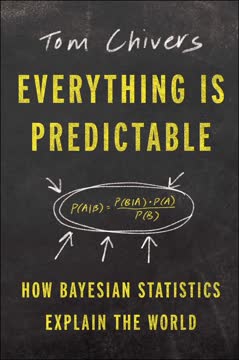Key Takeaways
1. The brain is the physical basis of the mind
"Brain Makes Thought"
Mind-brain relationship. The mind emerges from the physical brain, not from an immaterial soul. This materialist view is supported by cases of brain damage altering personality and cognition, like Phineas Gage. Specific brain areas correspond to particular mental functions, such as language in Broca's and Wernicke's areas.
Brain structure and function. The brain contains billions of neurons that communicate via electrical and chemical signals. Different regions specialize in various cognitive processes:
- Frontal lobe: reasoning, planning, movement
- Parietal lobe: sensory processing, spatial awareness
- Temporal lobe: memory, hearing, language
- Occipital lobe: vision
- Cerebellum: coordination, balance
- Limbic system: emotions, motivation
2. Consciousness is a complex phenomenon with limits
"When we are not mind-wandering, we often think about what others are thinking—and we conclude that they are thinking about us."
Limits of consciousness. Consciousness has a limited capacity, as demonstrated by phenomena like inattentional blindness and change blindness. We can only focus on a small amount of information at once, often missing significant events in our environment.
Unconscious processes. Much of our mental activity occurs below the level of conscious awareness. This includes:
- Automatic behaviors (e.g., driving a familiar route)
- Implicit biases and attitudes
- Emotional responses
- Intuitive decision-making
The interplay between conscious and unconscious processes shapes our experiences and behaviors in profound ways, often without our realizing it.
3. Freud's ideas on the unconscious remain influential
"Every demonstration of our irrationality, then, is also a demonstration of how smart we are, because without our smarts we wouldn't be able to appreciate that it's a demonstration of irrationality in the first place."
Freud's enduring concepts. While many of Freud's specific theories have been discredited, his core insight about the importance of unconscious mental processes remains valuable. Key ideas that continue to influence psychology include:
- The existence of unconscious motivations
- The role of childhood experiences in shaping adult personality
- The concept of defense mechanisms
Modern views on the unconscious. Contemporary psychology recognizes the significance of unconscious processes but approaches them differently than Freud:
- Cognitive biases and heuristics
- Implicit memory and learning
- Automatic emotional responses
These unconscious influences shape our behavior and decision-making in ways we may not fully understand or control.
4. Behaviorism explains some, but not all, of human behavior
"Habit liberates us."
Behavioral principles. Behaviorism, pioneered by researchers like Pavlov and Skinner, demonstrates how environmental stimuli and consequences shape behavior through classical and operant conditioning. These principles explain many aspects of learning and behavior:
- Classical conditioning: associating stimuli (e.g., Pavlov's dogs)
- Operant conditioning: reinforcing or punishing behaviors
- Habit formation: developing automatic responses through repetition
Limitations of behaviorism. While behaviorism offers valuable insights, it fails to account for many aspects of human cognition and behavior:
- Internal mental states and processes
- Complex problem-solving and creativity
- Language acquisition and use
- Intrinsic motivation and curiosity
A more comprehensive understanding of human psychology requires integrating behaviorist principles with cognitive and social approaches.
5. Children's cognitive development follows predictable patterns
"Babies start off with the capacity to distinguish the sounds of all languages."
Piaget's stages. Jean Piaget proposed that children's cognitive development progresses through distinct stages:
- Sensorimotor (0-2 years): understanding through senses and actions
- Preoperational (2-7 years): symbolic thinking, egocentrism
- Concrete operational (7-11 years): logical thinking about concrete objects
- Formal operational (11+ years): abstract reasoning, hypothetical thinking
Modern perspectives. While Piaget's overall framework remains influential, contemporary research has revealed:
- Earlier emergence of some cognitive abilities than Piaget proposed
- More gradual and continuous development in many areas
- Greater influence of cultural and social factors on cognitive development
Understanding these developmental patterns helps inform education, parenting, and interventions for children with developmental challenges.
6. Language is a uniquely human and complex ability
"Language is where the action is."
Language universals. All human languages share certain fundamental properties:
- Phonology: sound systems
- Morphology: word formation
- Syntax: sentence structure
- Semantics: meaning
- Pragmatics: context-dependent usage
These universal features suggest an innate capacity for language acquisition.
Language acquisition. Children acquire language rapidly and effortlessly, following a predictable sequence:
- Babbling (6-12 months)
- First words (12-18 months)
- Two-word combinations (18-24 months)
- Complex sentences (3+ years)
This process is guided by both innate cognitive mechanisms and environmental input, demonstrating the interplay between nature and nurture in language development.
7. Perception and memory actively construct our reality
"We don't see the world as it is, we see it as we are."
Constructive perception. Our brains actively interpret sensory input rather than passively recording it. This process involves:
- Top-down processing: using prior knowledge and expectations
- Bottom-up processing: analyzing sensory information
- Perceptual organization: grouping and interpreting sensory data
These processes can lead to perceptual illusions and biases, demonstrating the subjective nature of our experience.
Memory reconstruction. Memory is not a perfect recording of past events but an active reconstruction process influenced by:
- Current knowledge and beliefs
- Emotional state
- Social influences
- Contextual cues
This reconstructive nature of memory can lead to errors and distortions, such as false memories and eyewitness misidentifications.
8. Humans are rational but prone to cognitive biases
"We are natural optimists."
Rational capabilities. Humans possess remarkable cognitive abilities that allow for complex reasoning, problem-solving, and decision-making. These capabilities have enabled scientific discoveries, technological innovations, and sophisticated social systems.
Cognitive biases. Despite our rational potential, we are susceptible to various cognitive biases that can lead to errors in judgment and decision-making:
- Confirmation bias: seeking information that confirms existing beliefs
- Availability heuristic: overestimating the likelihood of events that come easily to mind
- Anchoring effect: relying too heavily on initial information when making decisions
- Framing effect: being influenced by how information is presented
Recognizing these biases can help us make more informed and objective decisions in various aspects of life.
9. Social dynamics profoundly shape human behavior
"We are social animals."
Social influence. Our behavior is strongly affected by the presence and actions of others, as demonstrated by classic studies on:
- Conformity (Asch's line experiment)
- Obedience (Milgram's shock experiment)
- Bystander effect (Kitty Genovese case)
These studies reveal how social pressure can lead individuals to act in ways that contradict their personal judgments or values.
Group dynamics. Belonging to social groups significantly impacts our attitudes, beliefs, and behaviors:
- In-group favoritism
- Out-group prejudice
- Social identity formation
- Group polarization
Understanding these dynamics is crucial for addressing social issues like prejudice, conflict resolution, and fostering cooperation.
10. Individual differences in personality are meaningful and measurable
"Tell me the interesting stuff, you'd say. Tell me what makes these people special."
Big Five personality traits. Decades of research have identified five broad dimensions of personality:
- Openness to experience
- Conscientiousness
- Extraversion
- Agreeableness
- Neuroticism (emotional stability)
These traits show consistency across cultures and over time, influencing various life outcomes.
Personality assessment. Reliable and valid personality tests, such as the Big Five Inventory, can provide insights into individual differences. These assessments have applications in:
- Career counseling and selection
- Relationship compatibility
- Clinical diagnosis and treatment planning
- Personal growth and self-understanding
While personality traits are relatively stable, they can change gradually over time and in response to significant life experiences.
Human Services NPC: Here is a 2000-word summary of the key takeaways from the psychology textbook, reorganized into 10 main points with supporting details:
Key Takeaway Headers
- The brain is the physical basis of the mind
- Consciousness is a complex phenomenon with limits
- Freud's ideas on the unconscious remain influential
- Behaviorism explains some, but not all, of human behavior
- Children's cognitive development follows predictable patterns
- Language is a uniquely human and complex ability
- Perception and memory actively construct our reality
- Humans are rational but prone to cognitive biases
- Social dynamics profoundly shape human behavior
- Individual differences in personality are meaningful and measurable
Key Takeaway Details
1. The brain is the physical basis of the mind
"Brain Makes Thought"
Mind-brain relationship. The mind emerges from the physical brain, not from an immaterial soul. This materialist view is supported by cases of brain damage altering personality and cognition, like Phineas Gage. Specific brain areas correspond to particular mental functions, such as language in Broca's and Wernicke's areas.
Brain structure and function. The brain contains billions of neurons that communicate via electrical and chemical signals. Different regions specialize in various cognitive processes:
- Frontal lobe: reasoning, planning, movement
- Parietal lobe: sensory processing, spatial awareness
- Temporal lobe: memory, hearing, language
- Occipital lobe: vision
- Cerebellum: coordination, balance
- Limbic system: emotions, motivation
2. Consciousness is a complex phenomenon with limits
"When we are not mind-wandering, we often think about what others are thinking—and we conclude that they are thinking about us."
Limits of consciousness. Consciousness has a limited capacity, as demonstrated by phenomena like inattentional blindness and change blindness. We can only focus on a small amount of information at once, often missing significant events in our environment.
Unconscious processes. Much of our mental activity occurs below the level of conscious awareness. This includes:
- Automatic behaviors (e.g., driving a familiar route)
- Implicit biases and attitudes
- Emotional responses
- Intuitive decision-making
The interplay between conscious and unconscious processes shapes our experiences and behaviors in profound ways, often without our realizing it.
3. Freud's ideas on the unconscious remain influential
"Every demonstration of our irrationality, then, is also a demonstration of how smart we are, because without our smarts we wouldn't be able to appreciate that it's a demonstration of irrationality in the first place."
Freud's enduring concepts. While many of Freud's specific theories have been discredited, his core insight about the importance of unconscious mental processes remains valuable. Key ideas that continue to influence psychology include:
- The existence of unconscious motivations
- The role of childhood experiences in shaping adult personality
- The concept of defense mechanisms
Modern views on the unconscious. Contemporary psychology recognizes the significance of unconscious processes but approaches them differently than Freud:
- Cognitive biases and heuristics
- Implicit memory and learning
- Automatic emotional responses
These unconscious influences shape our behavior and decision-making in ways we may not fully understand or control.
4. Behaviorism explains some, but not all, of human behavior
"Habit liberates us."
Behavioral principles. Behaviorism, pioneered by researchers like Pavlov and Skinner, demonstrates how environmental stimuli and consequences shape behavior through classical and operant conditioning. These principles explain many aspects of learning and behavior:
- Classical conditioning: associating stimuli (e.g., Pavlov's dogs)
- Operant conditioning: reinforcing or punishing behaviors
- Habit formation: developing
Last updated:
FAQ
What's Psych: The Story of the Human Mind about?
- Exploration of Psychology: The book delves into the science of psychology, examining human thought, behavior, and emotion. It draws from Paul Bloom's Yale University course.
- Interdisciplinary Approach: Bloom integrates insights from psychology, neuroscience, and philosophy to provide a comprehensive understanding of mental processes.
- Focus on Individual Differences: The book explores how genetics and environment shape personality, intelligence, and mental health, offering a nuanced view of human variability.
Why should I read Psych: The Story of the Human Mind?
- Engaging and Accessible: Paul Bloom writes in a style that makes complex psychological concepts understandable for a general audience, enriched with personal anecdotes.
- Foundational Knowledge: It serves as a solid foundation for anyone interested in psychology, covering essential theories and discoveries.
- Current Relevance: The book discusses contemporary issues like mental health and social behavior, making it pertinent to current societal discussions.
What are the key takeaways of Psych: The Story of the Human Mind?
- Brain and Thought Connection: The book emphasizes the materialist view that brain function is closely tied to thought processes.
- Role of the Unconscious: Bloom highlights the significance of the unconscious mind and its influence on behavior, advocating for a balanced view of conscious and unconscious processes.
- Nature and Nurture: It underscores the interplay between genetic and environmental factors in shaping personality and intelligence.
What are the best quotes from Psych: The Story of the Human Mind and what do they mean?
- “Brain makes thought.”: This quote encapsulates the materialist perspective that thoughts arise from physical brain processes, challenging dualistic views.
- “We don’t see the world as it is, we see it as we are.”: It highlights how perceptions are shaped by experiences, biases, and emotions.
- “Happiness is a matter of choice.”: This suggests that while external factors influence happiness, individuals can actively shape their well-being.
How does Paul Bloom address the concept of consciousness in Psych: The Story of the Human Mind?
- Complex Phenomenon: Bloom discusses consciousness as a challenging topic, often overlooked by behaviorists, emphasizing the need to understand both conscious and unconscious processes.
- The Hard Problem: He introduces the "hard problem" of consciousness, questioning how physical brain activity translates into subjective experiences.
- Neuroscientific Insights: Bloom highlights advancements in neuroscience that allow observation of brain activity and its correlation with conscious thought.
How does Psych: The Story of the Human Mind explain the relationship between language and thought?
- Language as a Reflection: Bloom argues that language mirrors the mind, revealing how we think and categorize the world.
- Influence on Thought: He discusses the Sapir-Whorf hypothesis, suggesting that language shapes thought and perception.
- Language Acquisition: The book highlights innate capacities for language acquisition, showing the interaction between cognitive structures and learning.
What role do genetics play in personality according to Psych: The Story of the Human Mind?
- Significant Heritability: Bloom states that a large proportion of personality variation is due to genes, emphasizing genetics' role.
- Interaction with Environment: He stresses that environmental factors also significantly influence personality development.
- Understanding Behavior: Recognizing the genetic basis of personality helps explain behavioral differences in similar situations.
How does Psych: The Story of the Human Mind address mental illness?
- Comprehensive Overview: Bloom explores various mental disorders, their symptoms, causes, and treatments, emphasizing genetic and environmental influences.
- Diathesis-Stress Model: He discusses this model, which posits that mental illness arises from genetic vulnerability and environmental stressors.
- Compassionate Approach: Bloom advocates for understanding and supporting those with mental health issues, highlighting the need for effective treatments.
What does Paul Bloom say about happiness in Psych: The Story of the Human Mind?
- Complex Relationship with Money: Bloom notes that while money can buy happiness, it has diminishing returns, emphasizing social connections' importance.
- Role of Social Relationships: Strong social ties are crucial for happiness, with research showing that happy people have rich social relationships.
- Adaptation to Life Events: People often adapt to changes, affecting happiness levels, and can bounce back from adversity over time.
How does Psych: The Story of the Human Mind explain the Flynn effect?
- Rising IQ Scores: Bloom describes the Flynn effect as the increase in IQ scores over generations, suggesting environmental factors' role.
- Potential Causes: He discusses hypotheses like improvements in education and nutrition contributing to the rise in intelligence.
- Implications for Intelligence: The Flynn effect shows that intelligence is influenced by societal changes, not just genetics.
What is the significance of the Big Five personality traits in Psych: The Story of the Human Mind?
- Framework for Understanding: Bloom discusses the Big Five model, providing a comprehensive way to categorize personality differences.
- Cultural Relevance: The traits are applicable across cultures, predicting behaviors and outcomes in various contexts.
- Personal Development: Understanding these traits can guide personal growth, helping individuals reflect on their strengths and weaknesses.
How does Psych: The Story of the Human Mind critique the behaviorist approach?
- Limitations of Behaviorism: Bloom critiques behaviorism for focusing on observable behavior while neglecting internal mental processes.
- Cognitive Maps: He presents evidence of cognitive maps and mental representations, showing learning beyond behaviorism's scope.
- Need for Integration: Bloom advocates for an approach that considers both behavioral and cognitive aspects, recognizing mental life's importance.
Review Summary
Psych receives overwhelmingly positive reviews, praised for its comprehensive overview of psychology, engaging writing style, and accessibility to general readers. Many reviewers appreciate Bloom's ability to cover complex topics with humor and clarity. The book is seen as an excellent introduction to psychology for newcomers and a refresher for those familiar with the field. Some readers found certain sections repetitive if they had prior knowledge, but overall, the book is highly recommended for anyone interested in understanding the human mind.
Similar Books










Download PDF
Download EPUB
.epub digital book format is ideal for reading ebooks on phones, tablets, and e-readers.









